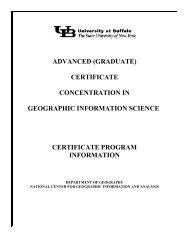Local Government GIS Demonstration Grant - NCGIA Buffalo
Local Government GIS Demonstration Grant - NCGIA Buffalo
Local Government GIS Demonstration Grant - NCGIA Buffalo
You also want an ePaper? Increase the reach of your titles
YUMPU automatically turns print PDFs into web optimized ePapers that Google loves.
Manager's Overview 7<br />
another agency, why enter into anagreement to pay for it? The answer is, of course, that the<br />
creating agency will not beable to sustain the <strong>GIS</strong> database under these circumstances. However,<br />
at this time , the set of state laws and regulations applicable to <strong>GIS</strong> data are not<br />
adequate to resolvecost issues and to facilitate regional data sharing<br />
cooperatives. New legislation willbe required. The New York State Temporary <strong>GIS</strong> Council<br />
did submitrecommendations on these issues to the Legislature in March 1996. Additionally,<br />
theNew York State Archives and Records Administration is currently in the process ofpreparing<br />
record management and retention schedules suitable for <strong>GIS</strong> data, both inindividual agencies and<br />
for shared databases. The New York State Office of Real Property Services has been designated<br />
as the <strong>GIS</strong> representative on the Governor's Task Force for Information Resource Management.<br />
One of the charges that has been given to the Task Force is to design a cohesive policy for the<br />
coordination of geographic information systems within New York building on the work of the<br />
Temporary <strong>GIS</strong> Council. Further information should be availablein late-1996 that should clarify<br />
the issues associated with arranging for data sharingamong governments.<br />
5 MANAGEMENT ISSUES IN <strong>GIS</strong> DEVELOPMENT<br />
Expected Benefits From The <strong>GIS</strong><br />
<strong>Local</strong> government need for, and use of, a <strong>GIS</strong> falls into several categories: maintaining<br />
publicrecords, responding to public inquiries for information, conducting<br />
studies and makingrecommendations to elected officials (decision-makers), and<br />
managing public facilities and services(utilities, garbage removal,<br />
transportation, etc.). The <strong>GIS</strong> tasks that meet these uses are:<br />
• Providing regular maps<br />
• Conducting spatial queries and displaying the results<br />
• Conductingcomplex spatial analyses<br />
Many of these tasks are already done by local government, althoughby manual means. The <strong>GIS</strong><br />
is able to perform these tasks much more efficiently. Some of theanalytical tasks cannot be<br />
performed without a computer due to their size and complexity. In thesecases, the <strong>GIS</strong> improves<br />
local government effectiveness by providing better information to plannersand decision-makers.<br />
Benefits from using a <strong>GIS</strong> fall into the two categories of: efficiency and effectiveness.<br />
Existingmanual tasks done more efficiently by the <strong>GIS</strong> result in a substantial savings of staff<br />
time. In thelocal government context, the largest savings come from answering citizen inquiries<br />
of many types. Depending on the size of the government, savings using the query function of<br />
a <strong>GIS</strong> can rangefrom 2 person-years for a smaller town, to 5-8 person years for a large town, to<br />
10 or more person-years for a large county. Estimates of potential time savings can be derived by<br />
measuring the timeto respond to a query manually and by <strong>GIS</strong> and multiplying the difference by<br />
the number ofexpected queries. This information is usually gathered during the Needs<br />
Assessment. Effectivenessbenefits are more difficult to estimate. The <strong>GIS</strong> may be used to<br />
accomplish several tasks that werenot previously done due to their size and complexity (e.g.,<br />
flow analysis in water and sewer systems,traffic analysis, etc.). As these are essentially new<br />
tasks, a comparison between manual and <strong>GIS</strong>methods is not possible. While not measurable, the<br />
benefits from these applications can besubstantial. Generally categorized as better planning,<br />
better or more effective decision-making,these applications support more effective




